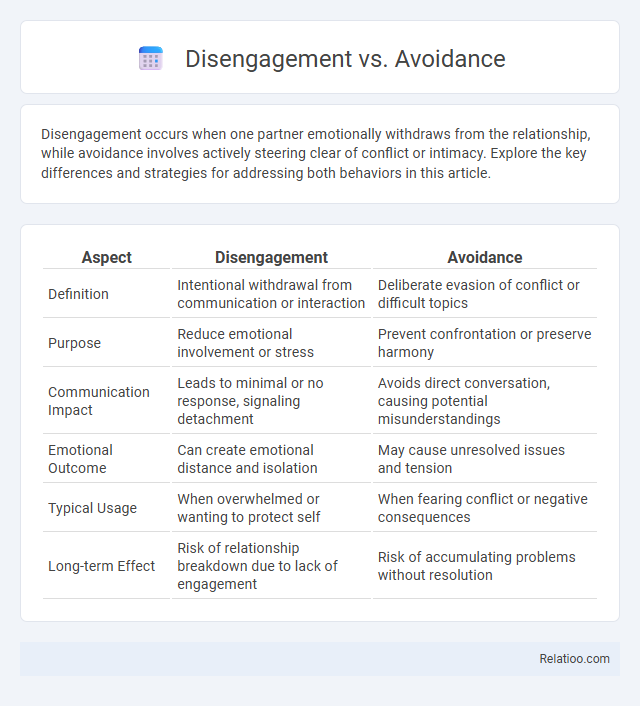Disengagement occurs when one partner emotionally withdraws from the relationship, while avoidance involves actively steering clear of conflict or intimacy. Explore the key differences and strategies for addressing both behaviors in this article.
Table of Comparison
| Aspect | Disengagement | Avoidance |
|---|---|---|
| Definition | Intentional withdrawal from communication or interaction | Deliberate evasion of conflict or difficult topics |
| Purpose | Reduce emotional involvement or stress | Prevent confrontation or preserve harmony |
| Communication Impact | Leads to minimal or no response, signaling detachment | Avoids direct conversation, causing potential misunderstandings |
| Emotional Outcome | Can create emotional distance and isolation | May cause unresolved issues and tension |
| Typical Usage | When overwhelmed or wanting to protect self | When fearing conflict or negative consequences |
| Long-term Effect | Risk of relationship breakdown due to lack of engagement | Risk of accumulating problems without resolution |
Understanding Disengagement and Avoidance
Disengagement and avoidance are distinct psychological responses to stress or conflict; disengagement involves withdrawing attention or effort from a task or relationship, while avoidance refers to actively steering clear of certain thoughts, feelings, or situations. Understanding disengagement highlights the passive reduction in involvement, often leading to decreased productivity or emotional connection. Avoidance tends to manifest as deliberate evasion, which can temporarily reduce distress but may perpetuate unresolved issues and increase anxiety over time.
Defining Key Differences
Disengagement refers to emotionally or mentally withdrawing from a situation, while avoidance involves actively steering clear of certain triggers or responsibilities. Disengagement is often passive and internal, whereas avoidance is a deliberate behavior aimed at preventing discomfort or conflict. Understanding these key differences helps you identify coping strategies and improve emotional resilience.
Psychological Roots of Disengagement
Disengagement stems from underlying psychological factors such as emotional exhaustion, decreased motivation, and a sense of helplessness, differentiating it from avoidance, which is often a deliberate act to escape discomfort. Avoidance behavior involves consciously steering clear of stressors, whereas disengagement reflects a more deep-seated withdrawal linked to unmet emotional needs or burnout. Understanding Your psychological roots of disengagement enables targeted interventions that restore engagement and improve mental well-being.
Causes and Triggers of Avoidance
Avoidance often stems from fear of failure, anxiety, or past negative experiences that trigger a protective response to evade discomfort or perceived threats. Your tendency to avoid certain tasks or situations usually arises when the brain associates them with stress or potential harm, reinforcing a cycle of inaction. Understanding these triggers--such as overwhelming pressure or lack of confidence--can help distinguish avoidance from disengagement, which involves loss of interest, and disengagement, related to withdrawal due to emotional exhaustion.
Impact on Relationships
Disengagement in relationships often leads to emotional distance and weakened communication, resulting in decreased intimacy and trust. Avoidance can create unresolved conflicts and build resentment, intensifying misunderstandings over time. Both behaviors undermine relationship stability by preventing healthy conflict resolution and emotional connection.
Effects in the Workplace
Disengagement in the workplace often leads to decreased productivity and low morale as employees withdraw emotionally or mentally from their tasks, impacting overall team performance. Avoidance behaviors can result in unresolved conflicts and missed deadlines, creating bottlenecks and fostering a negative work environment. Your ability to recognize and address these patterns early promotes healthier communication and improves organizational outcomes.
Consequences for Mental Health
Disengagement, avoidance, and withdrawal each uniquely impact mental health, often leading to increased stress and emotional distress when coping with challenges. Chronic disengagement can result in feelings of isolation and decreased motivation, while avoidance typically exacerbates anxiety by preventing effective problem-solving and emotional processing. Understanding how your tendencies toward these behaviors affect your mental well-being is essential for adopting healthier coping strategies and promoting emotional resilience.
Strategies to Address Disengagement
Strategies to address disengagement include fostering active participation through personalized learning experiences and clear goal-setting to enhance motivation. Implementing targeted feedback and social-emotional support can reduce withdrawal by increasing a sense of belonging and self-efficacy. Incorporating technology-driven tools like gamification and real-time analytics helps identify early signs of disengagement and tailor interventions effectively.
Overcoming Avoidance Behaviors
Overcoming avoidance behaviors requires identifying underlying triggers and implementing gradual exposure techniques to reduce fear and anxiety responses. Cognitive-behavioral strategies such as mindfulness and reframing negative thoughts help individuals confront challenges directly rather than withdrawing or disengaging. Consistent practice and support from therapy improve resilience, enabling effective engagement with tasks and relationships previously avoided.
Building Resilience and Engagement
Disengagement involves withdrawing effort or interest from challenges, while avoidance entails evading difficult situations altogether, both undermining your ability to build resilience and sustained engagement. Developing active coping strategies and facing challenges head-on strengthens emotional resilience and fosters deeper engagement with tasks and relationships. Building resilience requires cultivating awareness of these behaviors to replace avoidance and disengagement with proactive problem-solving and commitment.

Infographic: Disengagement vs Avoidance
 relatioo.com
relatioo.com